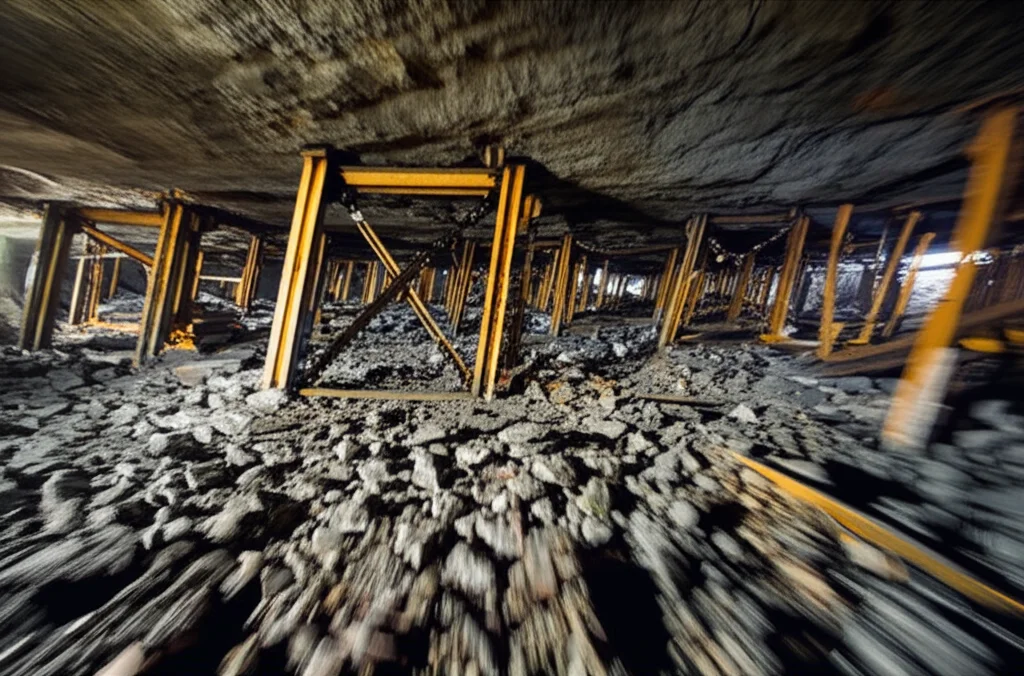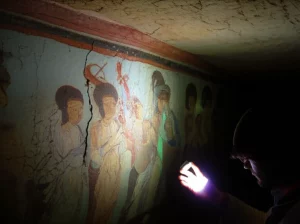Deep Trouble: Unpacking the Mystery of Composite Key Strata and Rock Bursts
Hey there! Ever wondered what goes on deep underground when we’re digging for coal? It’s not just dirt and rocks; it’s a complex, often very stressed environment. And sometimes, that stress can lead to something pretty terrifying: rock bursts. Imagine the ground suddenly and violently exploding – that’s a rock burst, and it’s a major hazard in mining.
As we dig deeper, especially in places like the Ordos mining area in China, the challenges get tougher. We’re dealing with higher stresses, hotter temperatures, water pressure, and constant disturbances from the mining itself. All this makes the ground behave differently, and unfortunately, it increases the risk of these dangerous events. A big culprit in Ordos seems to be the thick sandstone layers above the coal seams, particularly when they interact in a specific way.
Traditionally, we’ve had this concept called the “key strata theory.” It’s a neat idea that says certain thick, hard rock layers above the mining area are like the main beams holding everything up. When these “key strata” break, they control how the rock above them moves and how pressure is distributed. Before they break, they act like a big plate or beam; after they break, they form a kind of masonry structure that still influences things.
The Ordos Twist: Weak Sandstone and Composite Effects
But here’s where things get interesting, and a bit tricky, especially in places like Ordos. Unlike the hard, well-cemented sandstone in some older mining areas, the sandstone here is often weaker, with uneven particles, high porosity, and lots of natural fractures. Its strength is much lower – think below 30-40 MPa compared to over 60 MPa elsewhere. Despite being weak, these thick sandstone layers, sometimes interbedded, are still causing major problems, including high-energy microseismic events (basically, small underground earthquakes caused by mining) happening right in these weaker layers close to the coal seam.
The traditional theory, which often focuses on hard, hierarchical fracturing, didn’t quite fully explain why these rock bursts were happening in this weakly cemented rock. It left us scratching our heads about the exact mechanisms and why existing prevention methods weren’t always cutting it.
This is where the idea of “composite key strata” comes in. It’s an expansion of the original theory, suggesting that when two or more rock layers interact closely, their combined movement, deformation, and fracture can make them act like a single, much stronger, and stiffer unit. This “composite effect” significantly increases their load-bearing capacity.
Putting it to the Test: The 3-1402 Working Face Case Study
To get to the bottom of this, we decided to take a close look at a specific mining area known for rock bursts: the 3-1402 working face in Ordos. This place is deep, around 710m on average, and the coal seam itself is prone to bursting. We used monitoring systems, like the ARAMIS M/E system, to track microseismic (MS) events and rock bursts as mining progressed.
What did we find? Well, the high-energy MS events (those with energy ≥ 5 × 10⁴ J) were mostly happening in the thick sandstone layers of the Zhiluo Formation, about 30-80 meters above the coal seam. This told us these layers were highly active and critical in causing both rock bursts and significant tunnel deformation nearby. Horizontally, these events clustered towards the mining face’s tailgate and a 40m coal pillar – areas under high stress.
Comparing different sections of the working face, we saw that areas with multiple thick sandstone layers had significantly higher frequencies and total energy of high-energy MS events compared to adjacent areas. This strongly suggested that the way these layers were arranged and interacting was a big deal.
We also monitored the stress in the coal seam ahead of the working face using stress meters. We saw a distinct pattern:
- In-situ stress zone: Far ahead, stress was normal, undisturbed.
- Stress slowly rising zone: A bit closer, stress started creeping up, influenced by load transfer from the mined-out area.
- Stress rapidly rising zone: Much closer (50-240m ahead), stress shot up dramatically, peaking 45-60m out. The peak was 2.5 to 4 times the original stress! This is where the main load from the roof was hitting.
- Stress decreasing zone: Right at the face (0-50m), stress dropped as the coal failed plastically.
The deep stress meters showed an even wider and earlier stress increase, indicating that the load from the hanging roof was being transferred significantly ahead. And guess what? The area with higher MS activity also showed a slightly higher load transfer intensity. It all started pointing towards these thick layers and their combined effect.
We even had a rock burst happen during the study, causing significant damage – floor heave, roof subsidence, damaged supports, dust, and airflow. The source of this event was located right where we were seeing high MS activity and stress concentration, about 60m above the coal seam in those thick sandstone layers.

Cracking the Code: The Composite Key Strata Mechanism
Okay, so we saw *what* was happening underground. Now, *why*? We needed a theoretical model to explain how these thick, weak layers could team up to cause such trouble. We built a mechanical model based on composite beam theory, considering an upper layer, a lower layer, and any material in between.
The key idea for these layers to act as a single “composite key stratum” is that they have to move together synchronously, without slipping against each other. We developed criteria based on shear stress – basically, the forces trying to slide the layers apart. If the shear stress at the contact surfaces and within the layers (especially at the neutral axis of the composite beam structure) is less than the rock’s shear strength, they can stick together and behave as one unit.
Applying this to the specific layers in the high-risk area (drill hole 16-7), we calculated the shear stresses and found they were indeed below the rock’s shear strength. This confirmed that these thick sandstone layers *could* form a composite key stratum.
When these layers act as a composite unit, they become much stronger and can control a larger volume of rock above them. We calculated equivalent parameters for this composite layer (thickness, stiffness, etc.). Compared to analyzing the layers individually, the composite effect significantly increased the calculated controlled rock height and the length over which the layer could suspend before breaking.
Now, imagine this big, strong composite layer hanging over the mining face before it breaks. All the weight of the rock it controls is transferred to the coal seam ahead. This creates a significant increase in static load – a higher peak stress and a wider area of influence compared to what individual layers would cause. We calculated this stress increment, and it was notably higher and extended further ahead when considering the composite effect.
Then comes the breaking part. When this large, highly stressed composite structure finally fractures, it releases a huge amount of stored elastic energy. This release generates a strong dynamic load – those seismic waves we detect as high-energy MS events. We calculated this energy release, and it was significantly higher for the composite structure breaking compared to individual layers breaking asynchronously.
So, the mechanism becomes clear: the composite key strata effect leads to a superposition of high static loads (from the large suspended structure) and strong dynamic loads (from its intense fracture). This combined punch is what makes the coal seam ahead of the face so prone to violent rock bursts.

What Makes it Stronger? Factors Influencing the Composite Effect
Is this composite effect always equally strong? We used numerical simulations (with UDEC software) to explore this. We built models based on the Ordos geology and tweaked two main things: the thickness ratio between the upper and lower key strata, and the thickness of any weaker layer (intercalation) between them.
We looked at how the layers moved and fractured as mining progressed. The synchronicity of their movement and fracture is a key indicator of the composite effect’s strength.
Here’s what we found:
- Thickness Ratio: When the upper and lower layers had very different thicknesses (e.g., 5:2 or 2:5), they tended to move and fracture more independently, especially the thinner layer breaking first. But when their thicknesses were closer (like 4:3, 1:1, or 3:4), they moved and broke much more as a single unit, collapsing together into the mined-out area without much separation. The strongest composite effect, indicated by the highest peak advance stress, occurred when the thickness ratio was 1:1. So, layers of similar thickness are more likely to team up effectively.
- Intercalation Thickness: What about that weaker layer in between? If the intercalation was thin (0m, 10m, 20m), the upper and lower layers still fractured together, showing a strong composite effect and high peak stress. But as the intercalation got thicker (30m, 40m), the lower layer started breaking and collapsing earlier and separately from the upper layer. A distinct gap formed. This thicker intercalation disrupted the connection, weakened the composite effect, and reduced the peak advance stress. So, a thicker weak layer between the key strata acts like a buffer, preventing them from forming a strong composite unit.
These simulations confirmed our theory: the closer the key strata are in thickness, and the thinner any weak layer between them, the stronger the composite effect and the higher the risk of rock burst due to increased stress and energy release.
Fighting Back: Prevention and Control
Knowing the mechanism is one thing; preventing the rock bursts is another! Based on our findings, we proposed an optimized prevention scheme for areas identified as high-risk due to the composite key strata effect. The goal is to disrupt that strong composite connection and relieve the stress on the coal seam.
The scheme has two main parts:
- Overall Roof Weakening: We proposed increasing the depth of deep-hole pre-splitting blasting in the roof. The blasting should specifically target the middle/top of the lower thick key stratum and the bottom of the upper thick key stratum. The idea is to fracture these layers in key spots, weakening their integrity and making it harder for them to act as a single, strong composite unit. This encourages them to break asynchronously, reducing the sudden, large energy release. We also increased the amount of explosive used per meter in the blasting holes.
- Coal Seam Stress Relief: We also recommended using large-diameter pressure relief boreholes in the coal seam ahead of the working face. Drilling these holes weakens the coal itself and helps redistribute the stress, reducing the high concentration caused by the suspended composite roof. We increased the diameter, reduced the spacing between holes, and increased their depth to make this more effective.
We implemented this optimized scheme in one high-risk area (Region 2, corresponding to drill hole 16-5) and compared the results to another high-risk area where the scheme wasn’t applied (Region 1, corresponding to drill hole 16-7).
The results were pretty dramatic! In Region 2 (with the treatment), the frequency of high-energy MS events dropped by about 75%, and the total energy released dropped by a massive 88.2% compared to Region 1. The MS activity shifted from a scary “low-frequency, high-energy” pattern (typical of large, sudden fractures) to a much safer “high-frequency, low-energy” pattern (indicating more gradual, controlled fracturing). Energy density maps also showed a significant reduction in peak energy density and a smaller, more dispersed area of high energy concentration in the treated region.

The Takeaway
So, what did we learn from all this? For starters, in areas like Ordos with thick, weakly cemented sandstone, the traditional key strata theory needs an update. The concept of composite key strata is crucial. When these thick layers team up, they significantly increase the static load on the coal seam and release a powerful dynamic load when they fracture, creating a high risk of rock bursts.
The strength of this composite effect isn’t random; it’s strongest when the layers are of similar thickness and when there’s little to no weak material separating them. Understanding these factors helps us identify the riskiest areas.
Most importantly, we showed that targeted prevention measures – specifically weakening the composite structure in the roof and relieving stress in the coal seam – can be highly effective. By disrupting the composite effect, we can change the way the rock breaks and reduce the intensity of those dangerous high-energy events, making mining safer.
Of course, our theoretical model is a simplification, and real underground conditions are always complex. Implementing these measures can have its own challenges. But this study provides a solid theoretical foundation and practical evidence for tackling rock bursts induced by composite key strata in these challenging geological conditions. It’s a big step towards a safer future for deep mining!
Source: Springer







